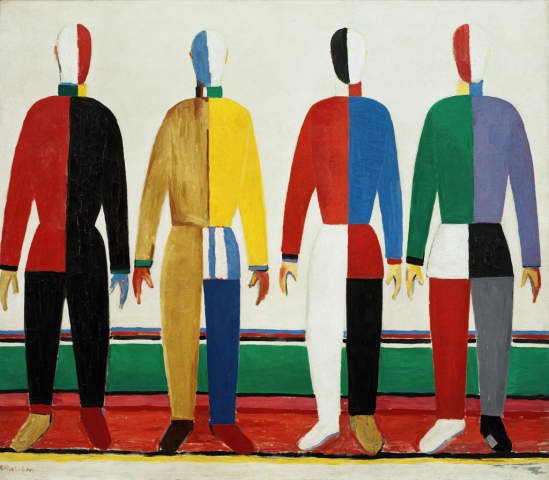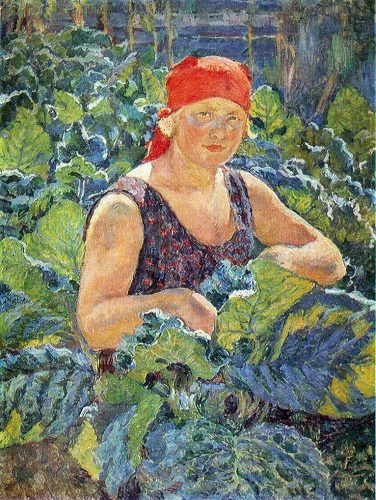Socialist Realism – Art and Culture in Socialism
Socialist Realism – Art and Culture in Socialism
“I turned into the zero point of form and from nothing I came to creation, that is, to Suprematism, to the new realism in painting – to non-representational creation.”[1] With these words the Russian painter Kazimir Malevich described his in 1916 Process from Futurism and Cubism to Suprematism. A modern art form in Russia that lasted until the 1930s and is considered one of the most important abstract art movements.
Art and culture should undoubtedly be associated with creative freedom and development for both recipients and creators, and should not be able to experience any limitations.
However, this was and is not the case everywhere in the world. Art movements, styles and phases have always been shaped by socio-cultural, political and economic circumstances. Censorship through political influences often led to completely new artistic expressions. But what happens when a state intervenes in the entire art and cultural world of a country? When all painters, writers, architects, musicians, etc. have to obey the most precise specifications and face dangerous consequences if they disobey?
A new art style that should stay
In 1932, the Communist Party of the Soviet Union, under then-Prime Minister Joseph Stalin, enacted a new state art style that would permeate and control the country’s entire cultural scene:
socialist realism. From now on, art was to serve as a means of state propaganda and depict the Soviet state and its ideals in a realistic form. Strict guidelines dictated exactly what could and could not be displayed.
Finally, in 1948, the then Soviet culture officer, Alexander Lwowitsch Dymschitz, demanded that socialist realism be extended to the entire Soviet zone of occupation. Until the 1990s, he then shaped and controlled all areas of the artistic world in socialist countries around the world. The new art direction was to focus on topics from Soviet working life and present them in a realistic form. Any deviations from the government guidelines were forbidden. Artists in the fields of painting, sculpture, architecture, music and all other applied arts were committed to the implementation of these ideals. Those who did not comply with the strict guidelines were punished with censorship and exclusion. As a result, many artists ended up in penal camps and prisons or were even murdered. Numerous people affected by the art scene fled into exile in order to be able to live and work there as free people.
How did that happen?
Socialist realism arose from a revolutionary consciousness in the 1920s and from a method of artistic design oriented towards the goals of the communist party. The societal and socialist-oriented awakening that echoed from the October Revolution of 1917 was reflected in the arts and finally culminated in a pluralism of styles.[2] In the early 1920s, abstract and representational art were given equal weight and a new avant-garde, inspired by social upheavals, emerged. Cultural associations were formed that primarily focused on a proletarian cultural revolution that would sweep through society. However, this phase of artistic freedom came to an end in 1928 with the beginning of Joseph Stalin’s autocracy and the introduction of his first five-year plan. The Soviet economy was now to be controlled centrally in the form of a planned economy that permeated all areas of public life. There was a forced reorganization of the socio-economic production conditions in the country, to which art and culture were also subjected.[3] The Central Committee of the Communist Party of the Soviet Union declared socialist realism to be the valid and binding aesthetic of the Soviet Union, which was to remain the only accepted art direction until the collapse of the state.

Pictures like this one from the 1920s, by painter Kasimir Severinovich Malevich, were banned in socialist realism.
What changed?
In the fine arts, social realism drew on the traditions of the so-called Peredvizhniki and the “Association of Artists of Revolutionary Russia”. The Peredvizhniki were a group of 19th-century Russian painters who were exponents of Realism.
The artists’ association was founded in 1922 and renamed the “Association of Artists of the Revolution” in 1928. In 1932 it was dissolved by Stalin and transferred to the Central Union of Artists of the Soviet Union. From 1934, by order of Stalin, everything that was creative was organized centrally. In their approach, the artists should always be “truthful” and “concrete”.
Metaphors and abstractions were forbidden. The people were to be portrayed as happy individuals loyal to the party and willing to work, so that a belief in the future of the Soviet Union could be created for the viewers of the art. With beautiful, realistic representations, optimism should be created in the population. All modernism, the avant-garde of the 1920s, and any art criticism or experiments that went beyond state guidelines were declared null and void in one fell swoop. Until the collapse of the Soviet Union, there remained a deep gulf between the artistic processes and the determining ideological norm in all the countries affected, which still has an impact today.

This work by Russian painter Ilya Ivanovich Mashkov is a good example of the Socialist Realism style. It depicts a woman harvesting tobacco.
This dossier aims to provide an insight into the art world of socialism. The works of numerous artists over several generations were shaped by the ideological claims of socialist realism. Those who stayed and submitted to the socialist adjustments benefited as artists in the service of the state. Those who disagreed with the ideology had to flee into exile.
Behind every work of art of this past time there are people and their stories, which are presented here in more detail.
Sources:
[1] https://beruhmte-zitate.de/zitate/1762316-kazimir-malevich-the-principal-element-of-suprematism-in-painting
[2] http://www.galerie-cyprian-brenner.de/kunstlexikon/kunstgeschichte/sozialistischer-realismus#kunstgeschichte
[3] https://www.grin.com/document/139275
Quelle Bild (Maler Kasimir Sewerinowitsch Malevich): https://www.kunst-fuer-alle.de/deutsch/kunst/kuenstler/kunstdruck/kasimir-sewerinowitsch-malewitsch/17321/1/115875
Quelle Bild (Maler Ilja Iwanowitsch Maschkow): https://commons.wikimedia.org/wiki/File:Ilya_Mashkov_-_Girl_on_the_tobacco_plantation.jpg
Artists of Socialist Realism
Artists of Socialist Realism


























